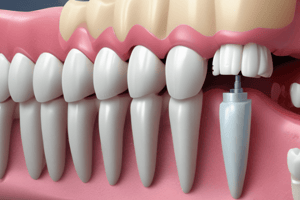Podcast
Questions and Answers
What is the first step in placing an amalgam restoration?
What is the first step in placing an amalgam restoration?
- Apply dentin desensitizer
- Mix the amalgam in the amalgamator
- Burnish the amalgam
- Prepare the cavity with undercuts (correct)
Which materials are commonly found in amalgam capsules?
Which materials are commonly found in amalgam capsules?
- Zinc and aluminum
- Mercury and silver alloys (correct)
- Plastic and ceramic
- Gold and nickel
What is the purpose of applying a dentin desensitizer during the amalgam restoration process?
What is the purpose of applying a dentin desensitizer during the amalgam restoration process?
- To block the exposed dentinal tubules (correct)
- To enhance the aesthetics of the restoration
- To prevent infection in the cavity
- To aid in the bonding of amalgam
What is one example of an indirect restoration?
What is one example of an indirect restoration?
During the process of making a removable denture, what is done after creating the wax frame?
During the process of making a removable denture, what is done after creating the wax frame?
What is the primary component used in the etching process for dental composites?
What is the primary component used in the etching process for dental composites?
Which type of composite is recommended for use in small low-stress bearing areas?
Which type of composite is recommended for use in small low-stress bearing areas?
What step must be performed prior to applying adhesive to achieve bonding with composite?
What step must be performed prior to applying adhesive to achieve bonding with composite?
What is the typical curing time range for composite materials using a light cure machine?
What is the typical curing time range for composite materials using a light cure machine?
Which generation of adhesive bonding systems is noted as the most used and latest?
Which generation of adhesive bonding systems is noted as the most used and latest?
Which type of composite would be categorized as having high filler content and high stiffness?
Which type of composite would be categorized as having high filler content and high stiffness?
What is the primary use of amalgam in dental restorative procedures?
What is the primary use of amalgam in dental restorative procedures?
Which characteristic distinguishes bulk-fill composites from conventional composites?
Which characteristic distinguishes bulk-fill composites from conventional composites?
Flashcards are hidden until you start studying
Study Notes
Dental Restorative Materials
- Used for filling cavities, covering discoloration, and correcting tooth alignment.
- Direct restorative materials are applied in a single office visit.
Composite Fillings
- Composed of plastic resin and powdered glass filler.
- Types include bulk-fill (up to 5 mm thickness), conventional (2 mm thickness), flowable, and packable.
- Flowable composites have low filler content, while packable composites have high filler content.
- Less polymerization shrinkage is observed in bulk-fill compared to conventional composites.
Etching and Bonding
- Etching involves phosphoric acid (34%-37%) to create micromechanical retention.
- Bonding process requires etching and priming to achieve a durable bond with composite.
- Adhesive generations vary from 3-step (etch, prime, adhesive) to 1-step systems that combine etch, prime, and adhesive.
Light Cure Machine
- Cures composite increments and bonding agents with a blue light.
- Curing times vary: composite (10-40 seconds) and bonding (10-20 seconds).
Amalgam Restorations
- Silver-colored restoration used predominantly in posterior teeth.
- Mixture contains mercury, separator, and silver alloys (copper/tin/silver).
- Retained in cavities through mechanical retention after proper cavity preparation.
Steps for Amalgam Restoration Placement
- Prepare the cavity with undercuts for retention.
- Apply dentin desensitizer, air dry after 30 seconds.
- Mix amalgam in an amalgamator for 6-8 seconds, then transport to the cavity.
- Fill cavity incrementally, condensing with a condenser.
- Use a burnisher to smooth and carve the anatomy of the restoration.
Indirect Restorations
- Created outside the mouth, then placed onto the affected tooth.
- Examples include crowns, bridges, dental implants, inlays, onlays, and veneers.
Fixed Prosthesis
- Types include PFM (porcelain fused to metal), full ceramic crowns, and full metal crowns.
Removable Partial Dentures
- Made from acrylic or chrome cobalt materials.
- Acrylic complete removable dentures are another option.
Process for Metal Framework of Removable Denture
- Design drawn, followed by wax frame creation.
- Wax is melted and replaced with metal to form the denture framework.
Studying That Suits You
Use AI to generate personalized quizzes and flashcards to suit your learning preferences.




